
◊◊◊
Children in the United States generally and (for this article) in Texas specifically are purposely being under-educated and mis-educated. Texas consistently ranks at the very bottom in the nation when it comes to education. The problem is not a lack of resources, it is not a lack of talent, and it is not because children here aren’t as good or something. The problem relates to those in power. Currently a racist, sexist, money hungry, uneducated group controls Texas. The use of standardized tests adds to the tight control politicians have over education, especially since we have a school board composed of members who are not educators and who are not subject matter experts. The state and governor continue to give businesses huge tax cuts, while raising taxes on everyone else and making draconian cuts to education. The problem is not a lack of money. Texas is the second richest state (largely from oil) in the nation. The 4th richest state has half the wealth of Texas. If Texas were its own nation, it would be the 15th wealthiest nation in the world. So there is plenty of money, if only education was actually valued. Here is an excellent video lecture/animation of a talk by Sir Ken Robinson where he describes what’s wrong with education today (please watch it after reading this article).
More than ever, we need to speak up and speak up often. We need to take back control of our state and nation. We need to make education a priority – a number one priority.
I have spent several days preparing this detailed—question-by-question and answer choice-by-answer choice—critique of the Social Studies State of Texas Assessment of Academic Readiness (STAAR) Test administered to 8th grade students in April 2013. Click here to view all the STAAR test administered this year.
Findings are very disturbing. The test is full of misleading information and propaganda. Pure. And. Simple. There is very little actual history. Questions and possible answers (including the “wrong” ones) are full of (mis)leading messages. In at least several cases, there is actually more than one possible “best answer” for a question. Altogether, this STAAR test reminds me more of a literacy test such as one the individuals racialized as black had to take or of a citizenship test.
According to the state’s definition and criteria, the 2013 8th grade Social Studies STAAR test had
- 20 History questions
- 12 Geography and Culture questions
- 12 Government and Citizenship questions
- 8 Economics, Science, Technology, and Society questions
An actual count of the 52 questions reveals something very different
- 32 relate to politics, specifically something about the Constitution, war, or presidents and others “great men” in virtually every case
- 8 relate to culture or religion
- 7 relate to economics, such as the strengths of capitalism and labor
- 5 relate to land, usually something about territories or Manifest Destiny
For the 208 possible answer choices
- 128 relate to politics
- 32 relate to economics
- 28 relate to land
- 20 relate to culture or religion
Questions and answers don’t come anywhere close to representing the variety of history studied and available (such as, there are no questions about individuals, or civil rights struggles). Political questions are great and needed, but the type of political questions possible is much larger, too. The “wrong answers” are just as important as the “right answer.” None of the questions and answers offer any criticism whatsoever of the United States, Texas, or any of their actions or practices. Worse, the questions and answer choices make it seem like we have had actually had a government that supports freedom and opportunity. Some parts of the test literally make me feel physically sick because they are so disgusting and misleading. Native Americans, Black Americans, women, and every day workers are completely omitted, presented as if they were actually the problem (in the case of Indians, for example), or presented as if they actually had significant opportunities and rights.
The test presents the United States as being a wonderful, unique nation that has committed no wrongs against anyone, either domestically or internationally. Additionally, while some of the questions ask for more than simple recall, the STAAR test doesn’t require any deep, high-level thinking (see Bloom’s Taxonomy). The STAAR test is in no reasonable way a measure of academic “readiness.” Students who can successful pass this will in no way automatically be prepared for success in college or in life. I hold the belief that questions requiring a written response are always better. And that it would take too long to grade is no excuse; there are plenty of qualified individuals who are unemployed and underemployed who would help.
Of course, the test does not necessarily directly mirror what happens in the classroom. I know about the STAAR test from reading about it and hearing about it. I know some of what goes on in classrooms from what students tell me. They say they spend all day, every day preparing for the test and going over the same material over and over. I know this doesn’t necessarily apply to every classroom, but I do know the state and administrators across the board put severe restrictions on what can and can’t be said in the classroom. I also specifically know that teachers simply aren’t able to do what they know is best, as this article discusses.
These problems are not limited to the 8th grade Social Studies test. The STAAR science exams utterly ignore evolution, teaches that individuals either learn or directly inherit everything from their parents, and in general presents a static view of the world. There is virtually no discussion of natural resources and human impact on the land, and there is absolutely no mention of oil.
What follows, as promised, is a detailed critique of the Social Studies test. I have each question as an image, and then my critique following. Please do read the full critique. It is usually long by necessity. Have an open mind, too.
We must recognize (as I do with my other studies of cultural artifacts) that each question–what it says and what it does not say–in the STAAR test tells us MORE about TODAY’S world, TODAY’S hopes and fears, TODAY’S agendas than any possible notion of anything related to legitimate social studies. We must also hypothesize possible deeper, long-term unconscious consequences of the test.
We desperately need a society that appreciates and understands history, politics, and our culture if we are ever going to work toward curing the disease of anti-intellectualism that plagues the United States.
◊◊◊
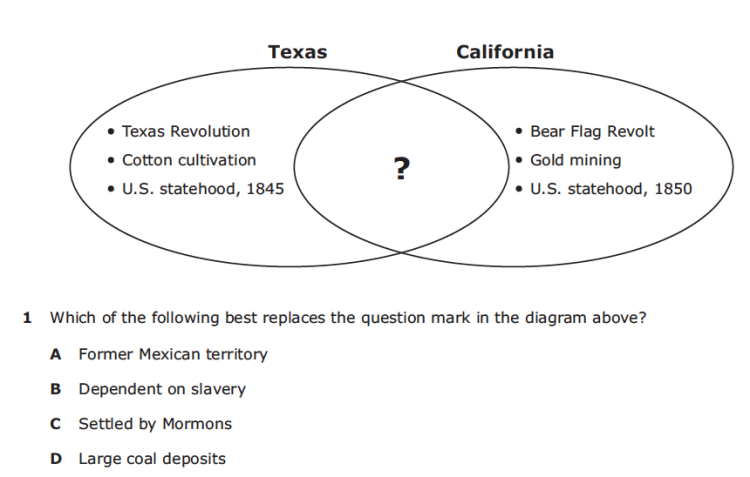
1. The question is looking for students to select “A” as the correct answer. Choices “C” and “D” are not really worthy of much consideration here. “C” could perhaps be viewed as insulting to Mormons since they have faced much discrimination and for either Texas or California to have been settled by Mormons would have been impossible.
Give the choices and the information in the diagram, I would select “B” as the correct answer. The Texas Revolution was only about people living in Texas fighting to maintain the right to enslave individuals racialized as black. Enslaved peoples made cotton. And the United States planned to adopt Texas as a slave state for some time. California was also dependent on enslavement though not as directly per se as Texas. California was made a state, in part, to help balance free states vs slave states. Other actions and events in either California or Texas were much more related to enslavement than having been part of Mexico at some point.
The state says “A” is the correct answer. This is problematic for several reasons in addition to my comments above. For one thing, the wording is “Mexican territory.” “Territory” implies something less temporary or different than a nation. Likewise, it privileges modern States. The areas of Texas and California also belonged to Spain and before that indigenous nations.
As far as the diagram specifically, the first two items of the California list really do not fit in with everything else that well.
Finally, this question, like public school history and museums in general for example, downplays the realities of enslavement. If we look at just the answer choices and consider what is most important for students to know, knowing about and recognizing slavery is far more significant than the other three choices.
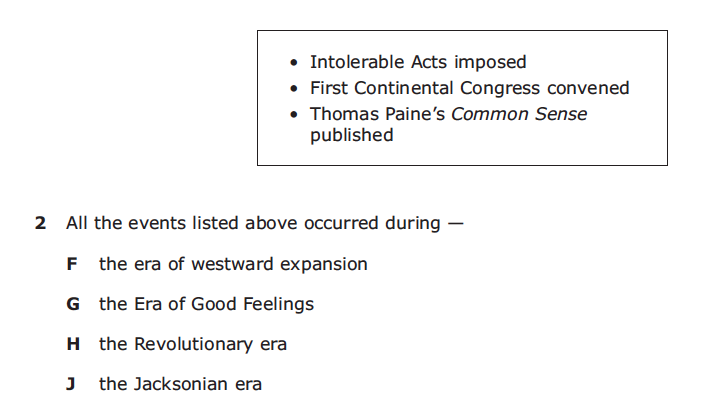
2. My only problem with this question is the use of “Intolerable Acts,” instead of “so-called Intolerable Acts,” or the name of one of the actual acts. As is, it is too leading and assumes one side was completely right and the other wrong. The answer is “H.”
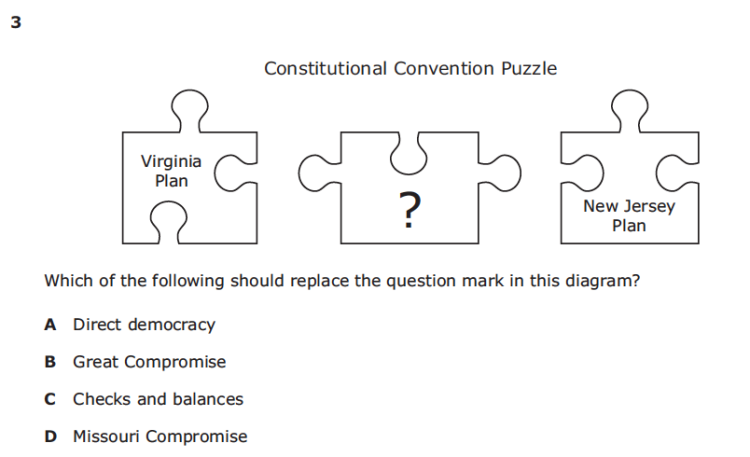
3. This question is okay. The first three choices are all heavily connoted with themes of “the US and its oh-so great democracy.” Direct democracy (“A”) and checks and balances (“C”) for all practical purposes do not exist in our nation, yet they remain important elements of propaganda. Questions also suggest that the Constitution was good and that (presumably) the Articles of Confederation were bad. The correct answer is “B”
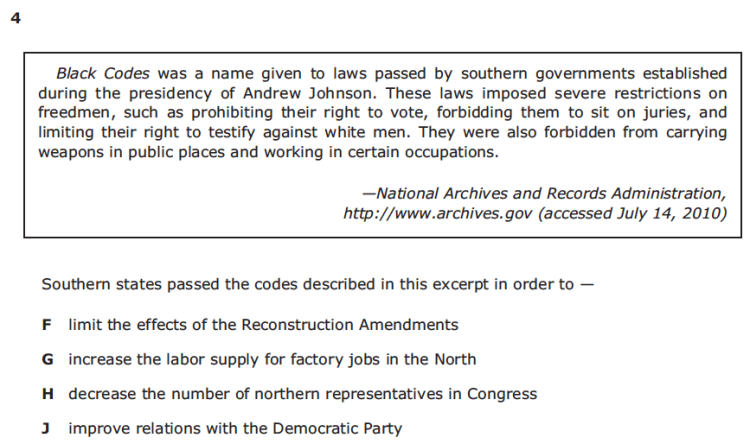
4. Where to begin? They do get credit for having an “anti-South” question. The text in the box is presented as if it is from a primary source. On another note, the passage never says who these laws specifically attacked. “Freedmen” is kind of close, but there were women, too, and as we know from history, African Americans throughout the nation were hardly “free” after the Civil War. Perhaps you could say “Black Codes” is being specific, but that is the name of a set of laws, not a group of people. Also the summary of the Black Codes provided isn’t nearly as harsh as things really were.
Again, on this one the answer choices are problematic and riddled with subtle messages. “F” is the correct answer. There is also something to choice “G” – especially given the North’s ultimate abandonment of African Americans after the Civil War. I also wonder what additional meaning there might be with choice “J” given the state of GOP’s and Tea Party’s extreme hatred of the Democratic Party.
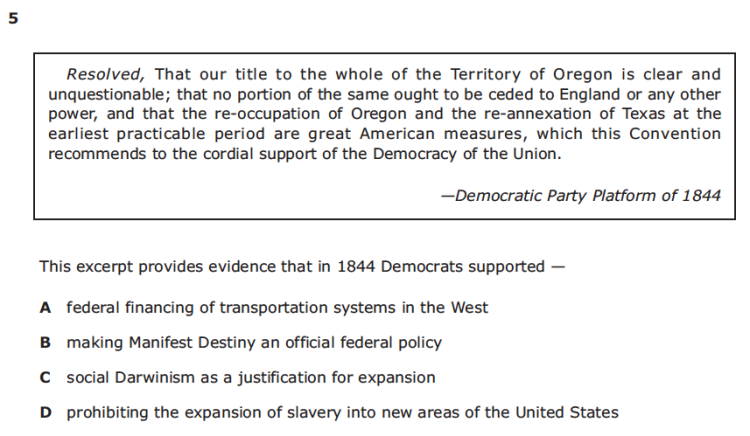
5. To start, the caption in the box should read, “Except from…” or have “…” at the beginning and end (as the test has on another question) especially since the section included is only 66 or 938 words in the original document. As in the previous question, it is worthy of note that the question and answers puts the Democratic Party in a negative light. Most people, especially 8th graders, do not know the difference between the parties over time. Also, Manifest Destiny (the correct answer) was an official and unofficial US policy that began with religious agenda. It’s much more complex than one political party’s goal. Blame also goes well beyond any one group. Likewise, in yet another question (as in #1) the choice with slavery is not the correct answer, and slavery is made to sound better that it really was.

6. Again another question with numerous problems. The framing of the question supports “great [white] men” history. It could have said something more along the lines of “What problem did the United States face in the 1780s?” or something like that. For the answer choices: “G” is the correct answer. “F” while really always true is not the answer they are looking for, and it plants the seed so to speak for an early right of states to leave the Union and thus eventually support the current political correct GOP version of the Civil War in Texas. Choice “J” is propaganda. The Articles of Confederation, according to many historians (especially so-called progressive, neo-progressive, and some Atlantic World historians) were primarily replaced with the Constitution so that the élite could regain power and control. The answer choice implies the Constitution was good and needed. Also choice “H” fits in with several other questions and answer choices that are distinctly anti-British.

7. I don’t have as many problem with this question. As with other questions, however, the “correct answer” could easily be connected directly with enslavement. “C” is the correct answer. One could probably make a good argument for “D” if proto-development were included and if it were recognized the economy remained productive because of enslaved individuals.

8. The question should read, “…many young WHITE and UNMARRIED women…” Also the possible answer choices embed unconscious messages that women had it much better much sooner. Choices “F,” “H,” and “J” are so unrealistic as to be insulting. “G” is the correct answer.
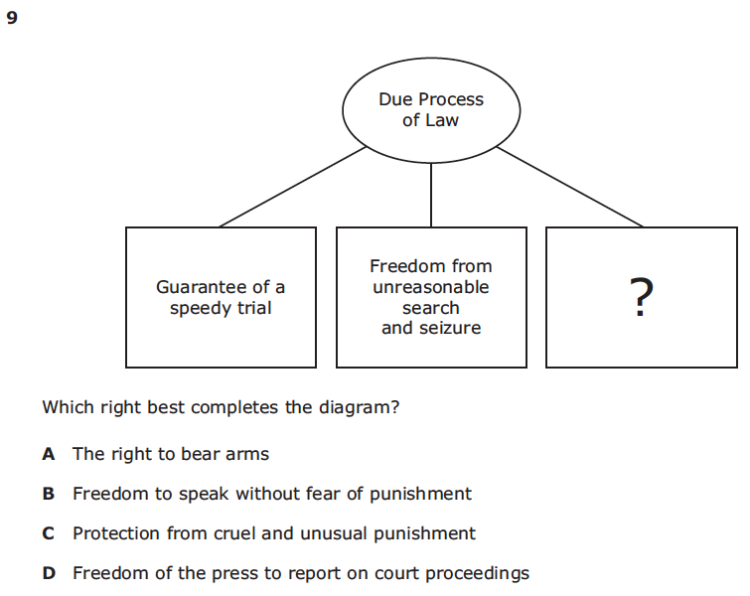
9. This question implies people actually had/have these rights. It totally ignores the gap between law and reality. It totally ignores court decisions made both in Texas and in the nation as a whole. No one gets a speedy trial – over 90% don’t even get a trial but get a plea bargain . People are searched all the time illegally. Need I continue listing the problems for this one? “C” is the state’s correct answer.

10. This question ignores that Indians lived in the lands west of the Appalachians. It also could have been phrased “states became greedy” or something to criticize the abuse these Indians faced en masse. “H” is the correct answer.

11. Answer choice “A” is insulting since labor unions are for all practical purposes illegal and powerless, especially in Texas. Additionally, the courts and big money have almost always fought labor unions or labor organizations as “communism.” Choice “B” and “C” both imply that our elected officials and government might have actually done something to help enslaved individuals. Congress and the SCOTUS continue to do everything they can to reinforce that we are “inherently unequal” (a good book has this as its title). “D” is the answer.

12. Choice “F” puts all the blame on Indians, as choice “H” (which is the correct answer) ignores Indians even existed.

13. Here the test is looking for students to select “D.” Again, this ignores the gap between the law and reality. It further ignores that formerly enslaved individuals generally had no money and no resources because they had been enslaved! It is good that the “correct answer,” was not something along the line of “abolished slavery” because Southerners used loopholes for almost another century to keep a significant number of African Americans enslaved. “D” also implies that all blacks in the south were enslaved. Finally, “D” suggest that if African Americans “are unhappy,” they can/should move somewhere else. Again choice “B” especially and somewhat “A,” imply the government cares for its citizens more than it does.
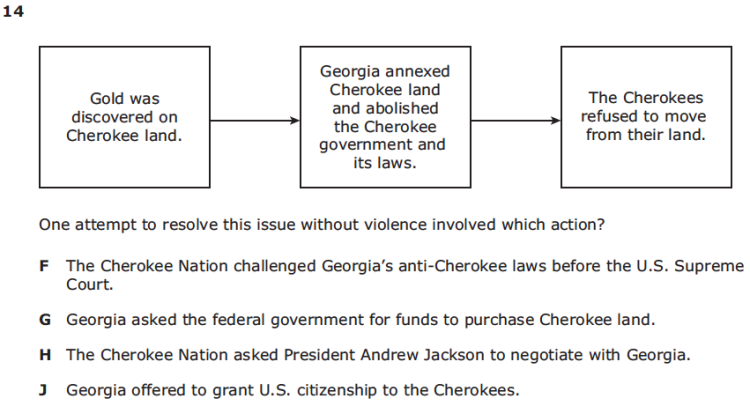
14. Choice “G,” “H,” and “J” all imply that Indians could have/did have it better than anything like what actually happened. Also the question makes it seem as if the Cherokee were responsible for perpetuating violence. “F” is correct.

15. Choice “C” is correct. Again, implies that jury duty actually really matters. Ignores the layers of bureaucracy separating courts, judges, defendants, and jurors. Also, another instance with an emphasis on the Constitution. Finally, as an educator, I would much rather student know larger ideas and histories behind the amendments, instead of basic memorization.
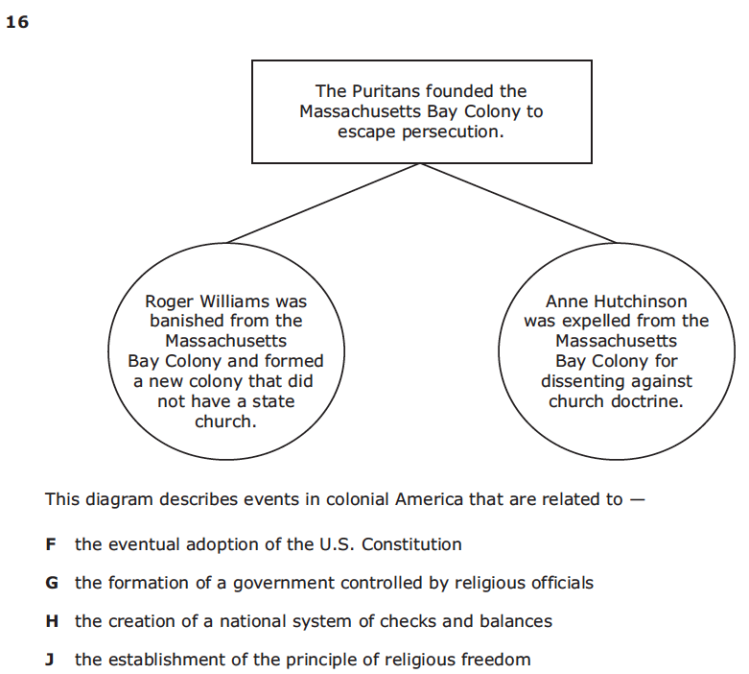
16. They are looking for “J” to be the correct answer. This point of view is egocentric and doesn’t recognize larger trajectories (namely the Reformation). Likewise, this is one of the few questions that discusses true persecution in the United States’s history – and the persecution in question involves “white” individuals.
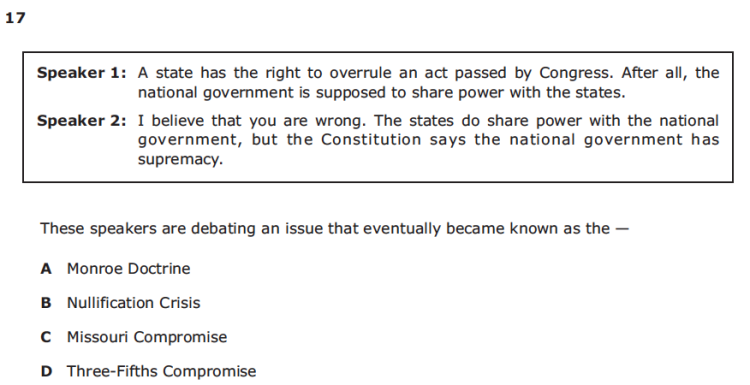
17. The speaker scenario makes government and politics seem far too simple, ideal, and utopian. Of course, the question needs to be at an appropriate-level – but come on. Answer is “B.”

18. Again as in 16, the question focuses on white people who faced persecution. Answer is “J.”

19. This is a question that touches of issues of civil rights and enslavement without really talking about them or talking about what really happened. “B” is the answer.

20. One major problems with this one other than it is kind of redundant of the first question in the test. Instead of “border disputes,” it could say something that recognizes the US was on a mission to kill and steal to get what it wanted. “H” is the correct answer.

21. Question (and answers) imply that the Irish found comfort and safety in the United States, and it ignores they had to fight to achieve “whiteness” and rights. Answer choices make the United States seem utopian and a safe places for refugees, while the world beyond is dangerous. Choice “C” has anti-British connotations. Correct answer is “B.”
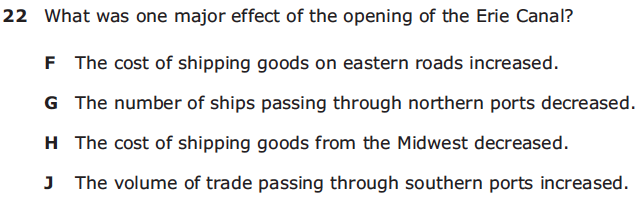 22. I have no problems with this question. “H” is the answer.
22. I have no problems with this question. “H” is the answer.
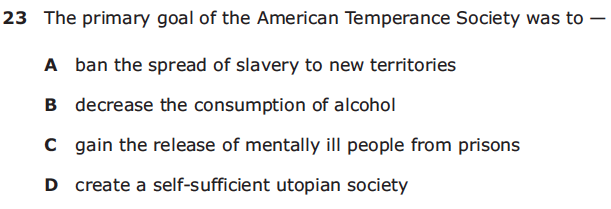 23. “B” is the correct answer. “A” again implies a better past with slavery than reality. This question, like the others, doesn’t get at any kind of larger historical backdrop/trajectory. In this case, anti-alcohol campaigns were part of a larger reform movement aiming to make conditions better across the board. Choice “D” is funny and ironic since this test generally ask questions about a utopian society that never has existed.
23. “B” is the correct answer. “A” again implies a better past with slavery than reality. This question, like the others, doesn’t get at any kind of larger historical backdrop/trajectory. In this case, anti-alcohol campaigns were part of a larger reform movement aiming to make conditions better across the board. Choice “D” is funny and ironic since this test generally ask questions about a utopian society that never has existed.

24. “F” is the correct answer. This question is surprisingly “on target.” It does, however, still focus on a political leader–variety would be nice. In reality, it was the public en masse that opposed the Constitution.
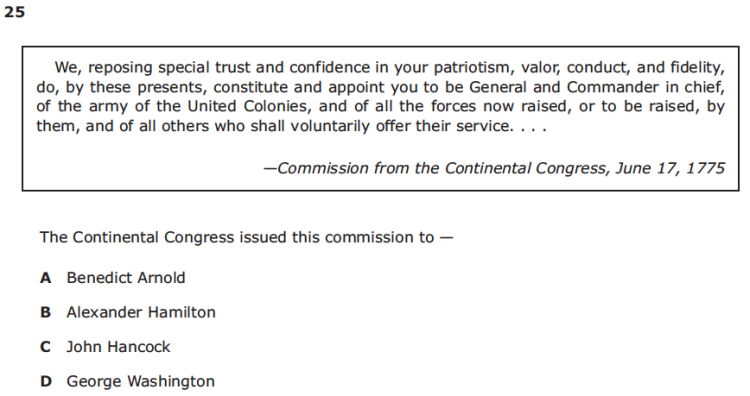
25. “D” is the answer here. Again, this focus on “great [white] men” history only.
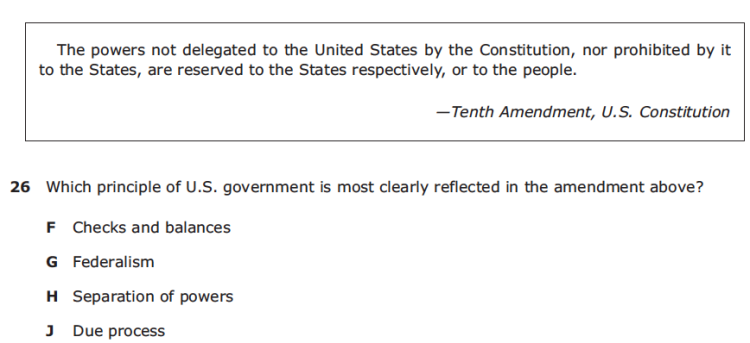 26. “G” is correct. Implies that these processes, both in the caption and in the answer choices, are important and real operations in our government.
26. “G” is correct. Implies that these processes, both in the caption and in the answer choices, are important and real operations in our government.

27. Relates to problems in #8 and #11 and others. When has the government EVER seriously supported women and their rights in any kind of meaningful, longterm way? Choices are so unrealistic as to be insulting. “C” is the answer they are looking for.

28. “F” is correct. No major problems with this one, except it is about slavery without specifically talking about slavery–again.
 29. They are looking for students to pick “C.” No critique for this one that I haven’t said over and over.
29. They are looking for students to pick “C.” No critique for this one that I haven’t said over and over.

30. I have a few problems with this one. First the way the question is worded: instead of saying “General Robert E. Lee,” it should say “After the South’s surrender…” The phrasing United States is problematic, too. It implies a diction between “us” and the United States. It should say, “the main priority of the nation’s political leaders was to.” This would be more parallel with the other questions. The way the original question is worded, it is almost as if the US is a different country than what the rest of the test covers. Also, there were many, many Southerners who had no wish to rejoin the US at all.
With the answer choices: “F” is insensitive since Abraham Lincoln was assassinated. “G” implies that the South made more advances and had more success than they did. “H” fits in with the theme in the South of blaming the North for everything. “J,” the correct answer of the test. Also “J” would be better worded as “implement a plan to fully rejoin the Southern states” or something, as technically the states never left the United States.
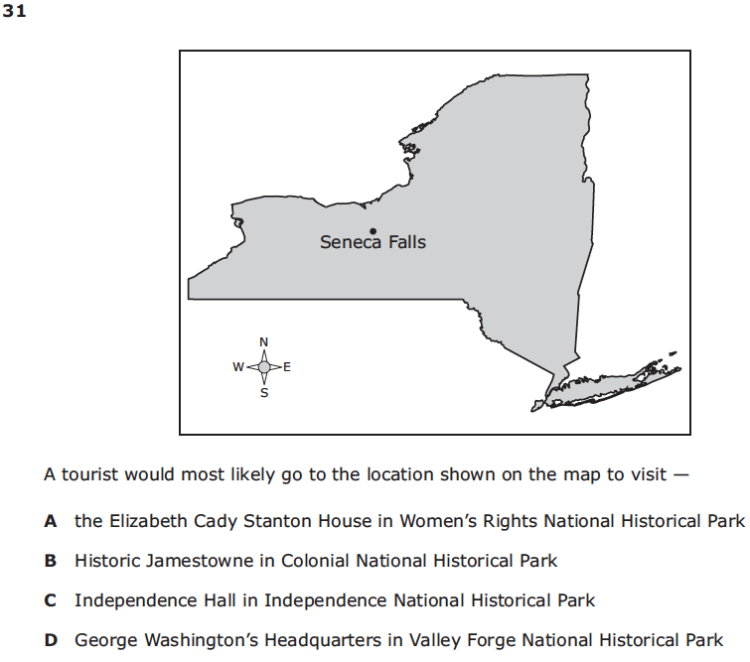
31. No major problems with this one. “A” is the answer. It is nice to see a nice question about a woman. The other three answer choices, however, remain topics of “great [white] men” history.
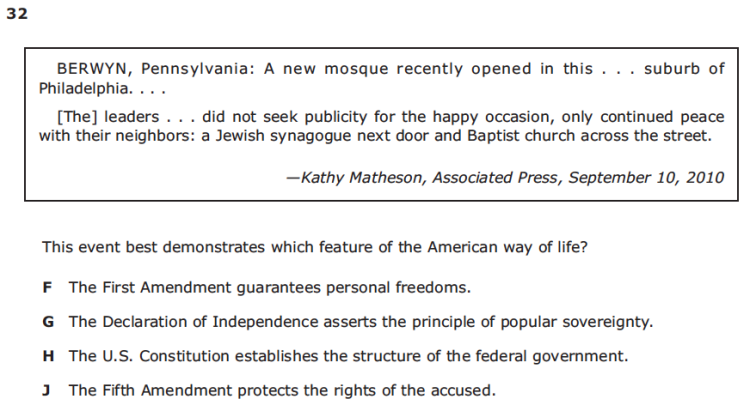
32. This question, like many of the others, speaks very directly to current issues and the very LACK of religious freedom in the United States. “F” is the answer students must selected. But, in reality, Muslims continue to face discrimination across the board in the United States. Additionally, anyone who doesn’t agree with the GOP’s version of Christianity faces near constant attacks on their civil and human rights. On the note of the other answer choices, “G,” “H,” and “J” all focus on rights and protections people have in the ideal only.
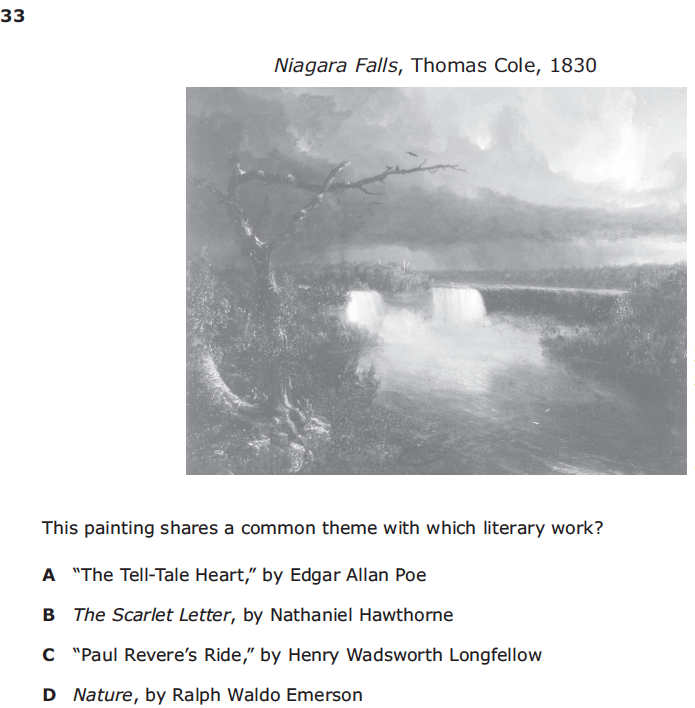
33. No problem with this one, except like virtually the entire test, it is about “great [white] men” and “high [white] culture.” I am glad there is a cultural question in the test. “D” is correct.

34. “J” is the correct answer for the test. Again, this question implies the Constitution was needed to save the United States. It ignores that the Constitution hurt the rights and opportunities of everyone except the elite.

35. “C” is what the test wants. To me, this question does not make much sense. Choice “B” is one of about a half-dozen answer choices that pretends unions are celebrated and welcomed in the United States. Labor unions are only discussed in this positive light throughout the test. In reality, Texas fights unions to the death, including unions for government employees.
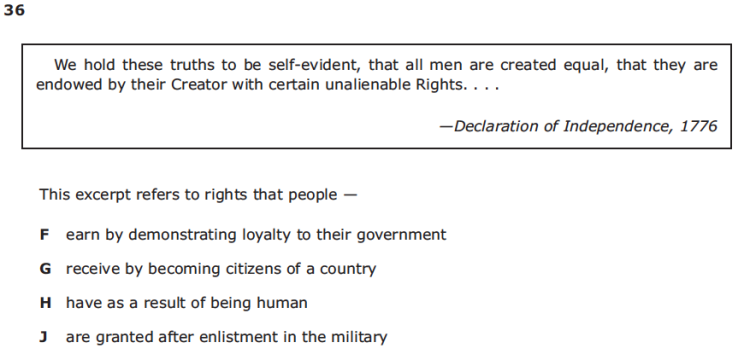
36. Question and answer choices promote the ideal government and rights we are supposed to have according to what we are told. The correct answer is “H.” The other choices, “F,” “G,” and “J,” all promote notions that citizens should be submissive to their country.
 37. “D” is the correct answer. Another “great men” question.
37. “D” is the correct answer. Another “great men” question.
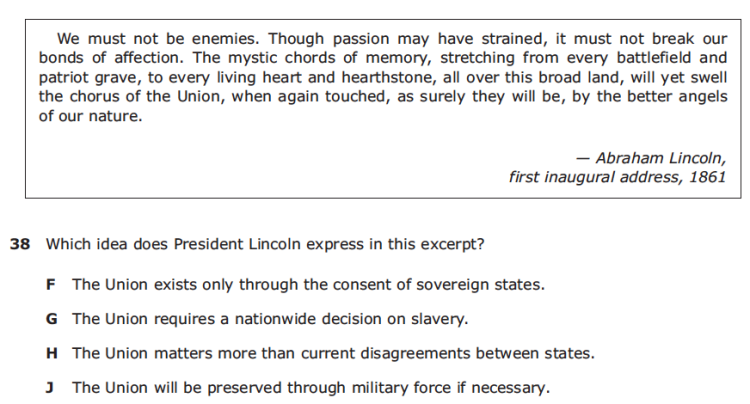
38. “H” is correct, but undermines the very real political, social, and moral issue enslavement played in the nation at that time. Choice “F” is an especially strong example of indoctrination and propaganda, especially considering all the people in Texas who want to leave the Union.

39. “A” is the answer. This question ignores the ultimate lack of “free-enterprise” in the West. Businesses, especially railroads, received huge tax cuts, free land, and then turned around and sold this land for outrageously high prices. It also ignores (like the entire test) problems within the United States that prompted individuals to seek opportunity in the West.
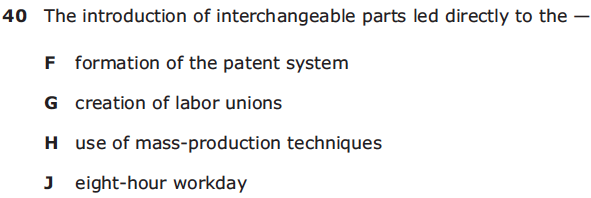 40. The answer choices here are very problematic. Unions are not supported or allowed by employers, and when they are allowed, their powers are greatly limited. 8 hour work day? I don’t know anyone with an 8 hour work day. Everyone I know either works way more than that to survive. Otherwise, they can’t get more work because their employer doesn’t want their workers to have more than 30 hours a week and a few hours each day because the employer doen’t want to provide health insurance. Regardless, people struggle to simply survive. The test is looking for students to select “H.”
40. The answer choices here are very problematic. Unions are not supported or allowed by employers, and when they are allowed, their powers are greatly limited. 8 hour work day? I don’t know anyone with an 8 hour work day. Everyone I know either works way more than that to survive. Otherwise, they can’t get more work because their employer doesn’t want their workers to have more than 30 hours a week and a few hours each day because the employer doen’t want to provide health insurance. Regardless, people struggle to simply survive. The test is looking for students to select “H.”
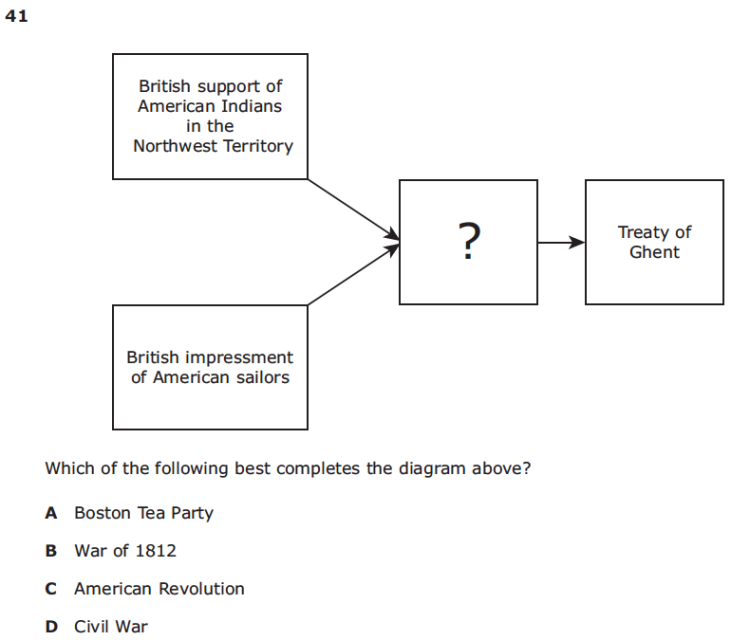
41. I have no problems with this question other than it too focuses on war and similar political conflicts, as do the overwhelming majority of questions. “B is the answer.
 42. The main problem here is that choice “H” – the correct answer – ignores that nations and peoples exist beyond the US. Individuals with the Mayflower were not the first to have ideas about self-government and social contracts, as the question implies.
42. The main problem here is that choice “H” – the correct answer – ignores that nations and peoples exist beyond the US. Individuals with the Mayflower were not the first to have ideas about self-government and social contracts, as the question implies.

43. “A” is the correct answer. Same criticism as on #24.

44. I’m basically okay with this one. The question, however, does overly homogenize people and pretends political differences did not exist before the 1790s. The Revolution clearly had “political parties” involved in practice, if not in name, for example. “J” is the correct answer.
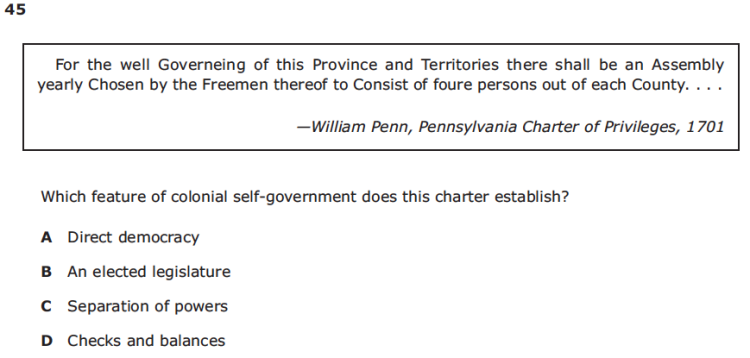
45. All of the possible answer choices are propaganda in order to make children think these actually happened/happen. It doesn’t dig deeper to investigate meanings or realities. “B” is correct.
 46. “G” is correct. I have no major problems with this one.
46. “G” is correct. I have no major problems with this one.

47. The test is looking for “C” to be correct. The other answer choices present a more repressive colonial environment (and thus anti-British message) than is generally argued to have existed.
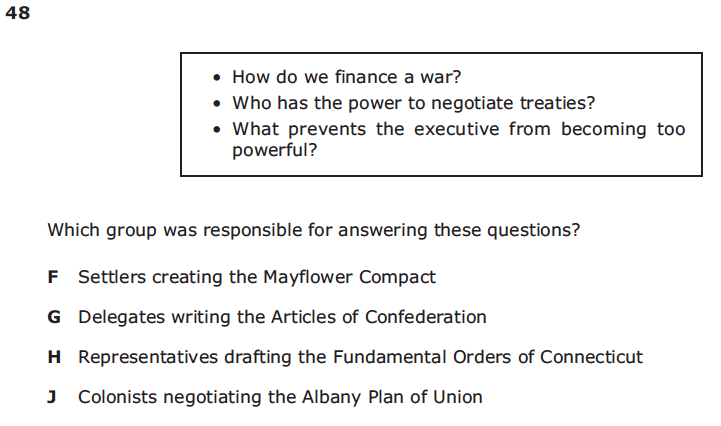
48. “G” is correct. This question does a nice job of showing the Articles of Confederation in a favorable light.

49. “D” is correct. I have no problems with this question.

50. This question is one of the more problematic questions on the exam. First, instead of “plantation system,” it should say “slavery” or (as I prefer) “enslavement.” Second, the entire question along with the correct answer (“G”) makes it sound as if slavery was a good thing. It offers no critique of the abuse of humans en masse for 250+ years. It ignores that “not paying people” is in no way capitalism or fair or humane. This “economic growth” is certainly not worthy of celebration as “development” implies. “F” and “H” imply that enslavement hurt white individuals or hurt the economy in some way. This question makes enslavement sound like the “good ole days.” In reality, enslaved individuals provided/created virtually all of the South’s and the nation’s wealth.
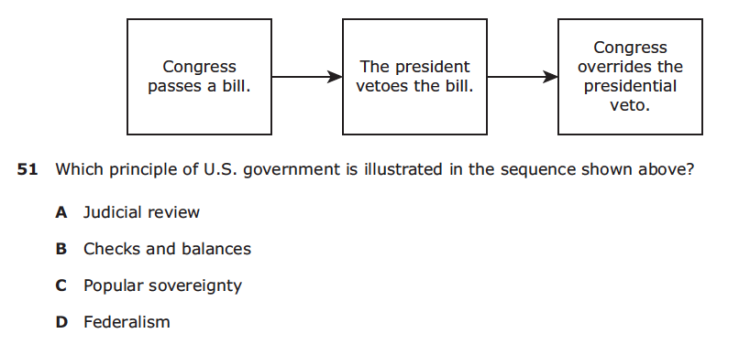
51. “B” is the correct answer. Yet again, this question promotes so-called Constitutional processes as if they were true and relevant.

52. “J” is the answer; however, there are countless more important consequences that could have been included – including further murder of Indians, the strong alignment between big business and the government against everyday people, etc.
◊◊◊
And that, my friends, is the 8th grade history test administered by the state of Texas. I hope this critique generates productive conversations and similar critiques. I briefly looked at some Florida tests and the New York History Test – both of these test have similar problems, but they both require a significant amount of additional reading and writing.
One example from the 5th grade science test deserves mention, too:

The first problem relates to that the new plant in question is an “Asian vine” that takes over and decreases the “native plants.” The picture is also grossly exaggerated. Such picture and question serve as anti-immigrant representations. Also, the answer is phrased with “native plants.” This neglects to recognize that animals and people transfer plants all the time, and as the environment changes, so too do what grows and lives where and when. This question, like the others, presents a static view of nature.
◊◊◊
Even if you don’t agree with every aspect of my analysis (and I hope we don’t fully agree per se – disagreement is great), I do hope that readers will think very deeply and critically about these issues. Consider all of the consequences and broader implications of standardized tests on this scale in general. I would love to get a productive conversation going in the comments.
I would love for others with the appropriate background/training to go through the math, reading, writing, and science tests and produce a similar critique. We need more critiques of the social studies test, too.
Thank you for taking time to read this. Please visit often.